Featured Articles
ARUM’S CHINESE ADVENTURE BEGAN WITH MARCO POLO

Even with modern jet travel, it takes nearly a full day to journey the 7,321 miles from Bob Arum’s headquarters in Las Vegas to Macao, China, where the 81-year-old founder of Top Rank is doing his 21st-century replication of the legendary Marco Polo.
Polo was the 13th-century Italian merchant whose adventures in the faraway lands of Central Asia and China, recounted in his book, The Travels of Marco Polo, did much to introduce Europeans of his day to exotic destinations they previously knew little or nothing about. It is said that Marco Polo even served as the inspiration for another Italian with wanderlust, Christopher Columbus , to set sail across the Atlantic Ocean in 1492. Columbus’ intention was to more easily facilitate his nation’s lucrative spice trade with Asia, principally Japan, but he “discovered” the New World instead. Of such mistakes is history sometimes made.
Or maybe Arum’s growing fascination with China, the world’s most populous nation (1.34 billion), and an increasingly important player on the world economic stage, also owes to other, more recent influences. You could say that Saturday’s six-round matchup in Macao of the newest and most intriguing addition to the Top Rank stable, Chinese flyweight Zou Shiming (1-0), and Mexico’s Jesus Ortega (3-1, 2 KOs) is as attributable to Ping-Pong diplomacy, NBA commissioner David Stern and former Houston Rockets center Yao Ming as it is to Marco Polo.
Heck, you might even include the Boxer Rebellion, which took place in China from 1899 to 1901 and pitted the secret society of “Boxers” – a common reference to the martial artists who were members of something known as the Society of Righteous and Harmonious Fists – against foreign imperialism and Christianity. The particulars of that scrap were recounted in a 1963 film, 55 Days at Peking, which starred Charlton Heston as a steadfast American Marine officer.
But while the 5-5, 112-pound Zou Shiming, a two-time Olympic gold medalist and three-time world amateur champion, represents the home front in a vast country Arum views as rich and fertile territory from which massive profits can be reaped, the notion of the People’s Republic of China as a preferred boxing destination will really gain traction if the Nov. 23 pairing in Macao of Top Rank’s longtime superstar, Manny Pacquiao (54-5-2, 38 KOs), and Brandon Rios (31-1-1, 23 KOs) sets off box-office fireworks.
If Pacquiao’s appearance in China is a resouding bottom-line success, and if Zou Shiming proves to be the pugilistic and financial success envisioned by Arum, don’t be surprised if more and more megafights wind up in China’s opulent gambling palaces (the anti-imperialist Boxers are already spinning in their graves) instead of the MGM Grand, Boardwalk Hall, Staples Center and Madison Square Garden. The money-hemorrhaging United States is on the hook for $1.1 trillion in public debt to China, one of its largest creditors, a fact that Arum and his bookkeepers no doubt are aware of.
“Zou is an incredible talent who is beloved in the People’s Republic of China,” Arum said of Saturday’s second appearance on familiar turf by the Chinese bell cow he expects will do for his company what the 7-6, 311-pound Yao Ming did for the NBA. “We at Top Rank will make every effort to make certain that he has a spectacular career as a professional boxer.”
The idea of some enterprising boxing entrepreneur establishing a foothold on the Chinese mainland has been floated for some time, predating even Arum’s expansionary vision for his Top Rank empire. But someone had to take the bold step of converting theory to reality, which is always the hard part, isn’t it?
On Jan. 25, 2000, when Mike Tyson was in London to hype his bout with England’s Julius Francis four nights later in Manchester, Tyson’s adviser, Shelly Finkel, dreamily spoke of a “world tour” in which the former heavyweight champion would travel the globe, for fun and profit, like a latter-day Marco Polo.
“South Africa and China want Mike, too,” Finkel said of his plans for the fading but still-popular Tyson. “The list is endless.” But Tyson, who had already fought twice in Tokyo and would later ply his trade in Scotland and Denmark, never got around to a business trip to China. Maybe the timing wasn’t quite right then.
Arum’s then-archrival, Don King, also publicly announced his intention to go to China right after Evander Holyfield reclaimed his WBA heavyweight title from John Ruiz in the second of their three bouts, on March 2, 2001, at Las Vegas’ Mandalay Bay. His Hairness’ plan was for the Holyfield-Ruiz rubber match to be promoted as the “Brawl at the Great Wall.”
“I’m going to do what I did in Zaire, Africa, 26 years ago,” King harrumphed, a reference to the Oct. 30, 1974, “Rumble in the Jungle” in which Muhammad Ali scored a stunning, eighth-round knockout of George Foreman. “We’re going to the great People’s Republic of China, where there hasn’t been a heavyweight bout of this magnitude in 5,000 years!” But while there was a third pairing Holyfield and Ruiz, it instead was staged at the Foxwoods Resort, in Mashantucket, Conn.
The slight opening of doors from the outside world to China, which had been mostly closed since the eight Western legations withdrew after the Boxer Rebellion, and were further locked down as a result of Mao Zedong’s establishment of Communism as mainland China’s official governmental organ on Oct. 1, 1949, probably can be traced to something which has come to be known as “Ping-Pong diplomacy.” It was major news when the U.S. Table Tennis team, which was on tour in Nagoya, Japan, in April 1971, surprisingly received an invitation to visit China. The trip to the PRC made by American ping-pongers and accompanying journalists helped thaw icy relations between the U.S. and China, and led to that now-famous handshake between American President Richard Nixon and Chinese Premier Zhou Enlai in 1972, in Beijing.
China is still a communist country, but its leaders of late have discovered there are certain benefits to crass capitalism. David Stern, with his grand plan to widen the NBA’s reach to worldwide proportions, so succeeded that some of the league’s most luminous stars have hailed from such far-flung outposts as Germany, Argentina, Croatia, Spain, Italy and, yes, China. Basketball boomed in popularity behind the erstwhile Bamboo Curtain when Yao Ming was selected as the No. 1 overall pick in the 2002 NBA draft, going on to become an eight-time All-Star Game and five-time All-NBA selection before chronic foot and ankle injuries forced his retirement in July 2011. When he finally bade his farewell , not only were Yao jerseys big sellers in America, but Kobe Bryant jerseys were worn by millions of Chinese kids who had developed a crush on hoops and the NBA’s hip-hop culture.
If Yao proved to be basketball’s strongest link between China and the U.S., why can’t the same hold true for a fighter who is 25 inches shorter and 200 pounds lighter than his gigantic countryman? Isn’t it a maxim that good things often come in small packages?
Zou Shiming is, in his own way, is as much of an ambassador for his sport as Yao was for his. China competed in its first Summer Olympics in 1952, in Helsinki, Finland, but the People’s Republic did not make another such appearance until the 1984 Los Angeles Olympiad. The Chinese, despite being a bit late to the party, have enthusiastically come to view athletics as a means to international prestige and national prosperity; since ’84 they have amassed 201 gold medals, 144 silvers and 128 bronzes, and in 2008 Beijing was the site of the Summer Games.
Among China’s foremost sports figures is Zou, from Zunyi, in southwest China’s Guizhou province, who became his nation’s first Olympic boxing medalist when he took a bronze in the 2004 Athens Games. Since then he has added golds in 2008 and in 2012 in London, each victory expotentially increasing his popularity and prestige in his homeland. Although he is no kid at 32, Zou, who lists his personal heroes as Muhammad Ali and Jackie Chan, presumably has enough tread on his competitive tires to make a run at a professional world championship, which also would be a first for his country.
With Freddie Roach, the Boxing Writers Association of America’s five-time Trainer of the Year, to smooth his transition from the amateurs to the pros, the hope was that Zou could be fast-tracked to a title shot within two years of his signing by Top Rank on Jan. 23, 2013. It still might happen, but his debut in the punch-for-pay ranks met with mixed reviews as he scored a desultory four-round decision over Mexico’s Eleazar Valenzuela on April 6, also in Macao.
“Though I have been in boxing for many years, it was mainly in the Olympics,” Zou said in a story that appeared in the South China Morning Post. “I showed many shortcomings in the first fight, but I think that I will be more mature after more bouts.”
Roach theorized that “the crowd got to him. He didn’t perform as well as I thought he would. He got nervous and a little gun-shy. These things happen, but now we need to see that go away. If he looks sensational in this fight (against Ortega), as he should, then we will talk about moving out (toward a hoped-for title shot before the end of 2014).”
If Zou proves to have the goods, it would mark another breakthrough for Arum regarding the lower weight classes, which typically have had difficulties finding an audience in the U.S. Most fighters from bantamweight on down are almost obliged to seek bouts in Asia or Central America, regardless of their country of origin, because Americans tend to overlook the little guys. But Arum proved it is possible to pound a square peg into a round hole when he promoted the junior flyweight unification showdown between Michael Carbajal and Humberto “Chiquita” Gonzalez on March 13, 1993, at the Las Vegas Hilton. The diminutive dynamos each earned million-dollar purses, become the first fighters in their weight class to do so, and the classic bout – in which Carbajal went on to win on a seventh-round stoppage after twice climbing off the canvas following knockdowns – was named “Fight of the Year” by The Ring. Carbajal also was selected as the magazine’s Fighter of the Year.
As was the case with Yao Ming, Zou’s hope is to make his mark not only in China, but in America. He said it is his dream to fight in places like Vegas, New York or Los Angeles, where the fighters he worshiped as a youth – not to mention the legacy of Marco Polo — taught him that the world is indeed a very large and interesting place.
-
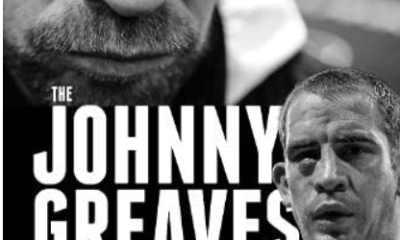
 Featured Articles3 weeks ago
Featured Articles3 weeks agoThomas Hauser’s Literary Notes: Johnny Greaves Tells a Sad Tale
-
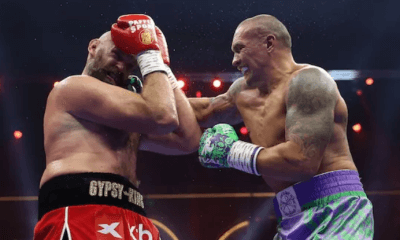
 Featured Articles2 weeks ago
Featured Articles2 weeks agoBoxing Notes and Nuggets from Thomas Hauser
-
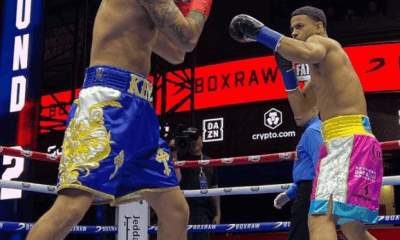
 Featured Articles4 weeks ago
Featured Articles4 weeks agoRolly Romero Upsets Ryan Garcia in the Finale of a Times Square Tripleheader
-
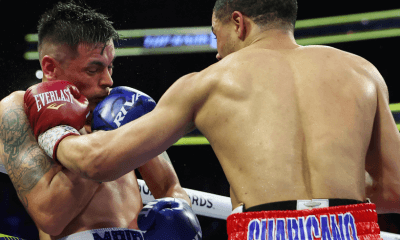
 Featured Articles4 weeks ago
Featured Articles4 weeks agoUndercard Results and Recaps from the Inoue-Cardenas Show in Las Vegas
-
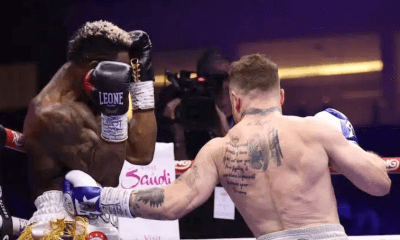
 Featured Articles4 weeks ago
Featured Articles4 weeks agoCanelo Alvarez Upends Dancing Machine William Scull in Saudi Arabia
-
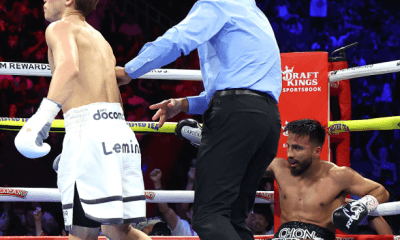
 Featured Articles4 weeks ago
Featured Articles4 weeks agoBombs Away in Las Vegas where Inoue and Espinoza Scored Smashing Triumphs
-
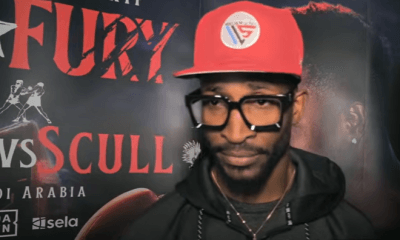
 Featured Articles4 weeks ago
Featured Articles4 weeks agoArne’s Almanac: The Good, the Bad, and the (Mostly) Ugly; a Weekend Boxing Recap and More
-
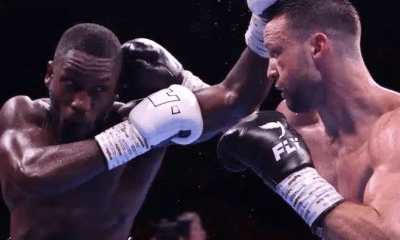
 Featured Articles1 week ago
Featured Articles1 week agoEkow Essuman Upsets Josh Taylor and Moses Itauma Blasts Out Mike Balogun in Glasgow



















